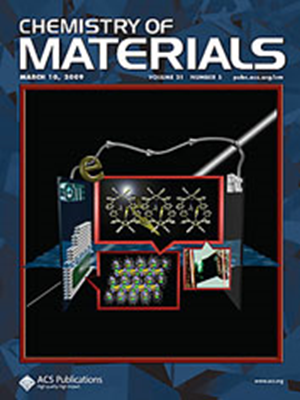Dual-Channel Control of Ferroelasticity in a Soft Molecular Crystal Induced by Perfluorinated Substitution
IF 7
2区 材料科学
Q2 CHEMISTRY, PHYSICAL
引用次数: 0
Abstract
Molecular ferroelastic materials have been widely studied because of their superior physical properties including lightweight, good biocompatibility, structural tunability, and low acoustic impedance. However, the discovery of molecular ferroelastic materials with desirable mechanical properties seems like looking for a needle in a haystack due to the lack of effective theories to control and optimize ferroelasticity. In this work, we successfully constructed the molecular ferroelastic material amantadine–pentafluorobenzoic acid (AM-PFBA) based on the chemical design strategy of perfluorinated substitution. AM-PFBA undergoes a ferroelastic phase transition with the Aizu notation of 2/mF at 354 K. The stripe-shaped ferroelastic domains can be reoriented under temperature or stress. Notably, AM-PFBA shows good mechanical flexibility with a small elastic modulus (E) of 6.45 GPa and hardness (H) of 0.32 GPa, which is much smaller than that of most organic crystals. Such a unique mechanical property of AM-PFBA crystal may be attributed to the introduction of fluorine atoms. This work offers an efficient strategy for precisely designing high-performance molecular ferroelastic.

全氟替代诱导软分子晶体铁弹性的双通道控制
分子铁弹性材料具有重量轻、生物相容性好、结构可调、声阻抗低等优越的物理特性,因此被广泛研究。然而,由于缺乏控制和优化铁弹性的有效理论,发现具有理想机械性能的分子铁弹性材料无异于大海捞针。在这项工作中,我们基于全氟取代的化学设计策略,成功构建了金刚烷-五氟苯甲酸(AM-PFBA)分子铁弹性材料。AM-PFBA在354 K时发生铁弹性相变,会津符号为2/mF1¯1¯1¯。值得注意的是,AM-PFBA 具有良好的机械柔韧性,其弹性模量(E)为 6.45 GPa,硬度(H)为 0.32 GPa,远小于大多数有机晶体。AM-PFBA 晶体之所以具有如此独特的机械特性,可能与氟原子的引入有关。这项工作为精确设计高性能分子铁弹性体提供了一种有效的策略。
本文章由计算机程序翻译,如有差异,请以英文原文为准。
求助全文
约1分钟内获得全文
求助全文
来源期刊

Chemistry of Materials
工程技术-材料科学:综合
CiteScore
14.10
自引率
5.80%
发文量
929
审稿时长
1.5 months
期刊介绍:
The journal Chemistry of Materials focuses on publishing original research at the intersection of materials science and chemistry. The studies published in the journal involve chemistry as a prominent component and explore topics such as the design, synthesis, characterization, processing, understanding, and application of functional or potentially functional materials. The journal covers various areas of interest, including inorganic and organic solid-state chemistry, nanomaterials, biomaterials, thin films and polymers, and composite/hybrid materials. The journal particularly seeks papers that highlight the creation or development of innovative materials with novel optical, electrical, magnetic, catalytic, or mechanical properties. It is essential that manuscripts on these topics have a primary focus on the chemistry of materials and represent a significant advancement compared to prior research. Before external reviews are sought, submitted manuscripts undergo a review process by a minimum of two editors to ensure their appropriateness for the journal and the presence of sufficient evidence of a significant advance that will be of broad interest to the materials chemistry community.
 求助内容:
求助内容: 应助结果提醒方式:
应助结果提醒方式:


